Industrial doors are a key component of modern factories, warehouses, logistics centers, and other facilities. They affect the efficiency of daily operations and involve safety, energy savings, and maintenance costs. With the accelerated process of industrialization, enterprises have increasingly high requirements for door performance.Fast Overhead Door is gradually replacing traditional industrial doors as the first choice of modern enterprises due to its advantages of high efficiency, safety, and energy saving. However, traditional industrial doors are still widely used in specific scenarios due to their low cost and simple structure.
This guide will provide a detailed comparison between Fast Overhead Door and traditional industrial doors, including types, features, advantages and disadvantages, applicable scenarios, cost-effectiveness, and return on investment, to help enterprises make optimal decisions.
Types and Features of Fast Overhead Door
High Speed Roll Up Door
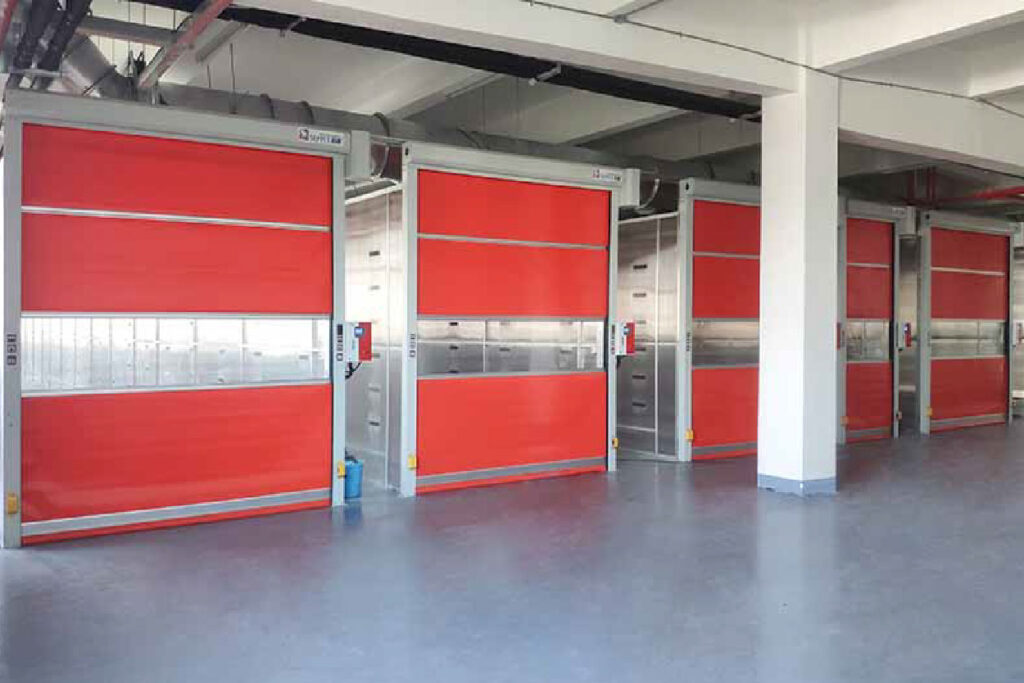
High Speed Roll Up Door is a high speed automatic door made of flexible PVC or composite material, usually used in industrial environments with high frequency opening and closing. The door curtain can be rolled up quickly, occupies little space, and at the same time has excellent sealing and thermal insulation.
Features:
Made from high-strength PVC or composite materials to ensure a durable and lightweight door.
Speeds of 0.8m/s – 2.0m/s significantly increase the efficiency of logistics movement.
Strong sealing, can effectively reduce air leakage, improve cleanliness and save energy.
Applicable scenes:
Logistics warehousing: for frequent access to loading and unloading areas to ensure efficient operation.
Food processing: Provide good hygiene control to prevent external contaminants from entering the production area.
Pharmaceutical manufacturing: Maintaining cleanroom environments to meet strict GMP certification requirements.
High Speed Spiral Door
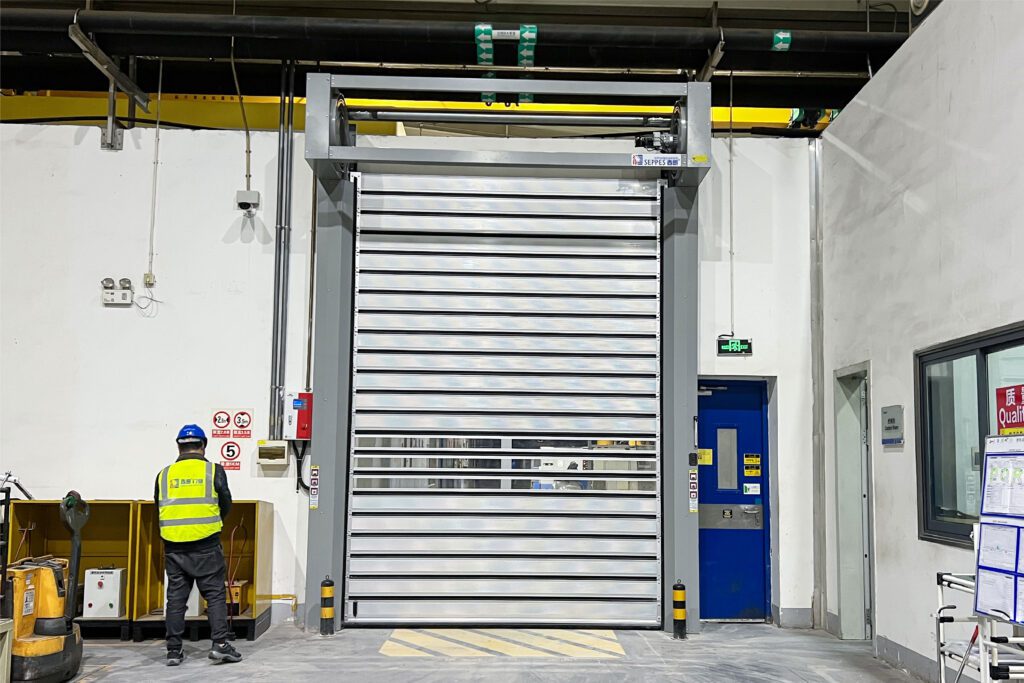
The High Speed Spiral Door features rigid aluminum or steel panels that run along a spiral track, providing greater stability and offering greater wind resistance than traditional up-and-over doors.
Features:
Excellent durability with high-strength aluminum alloy or steel door panels.
Opening and closing speeds of up to 0.8m/s – 1.5m/s, improving the efficiency of vehicle and personnel traffic.
Suitable for outdoor installation, with very high wind resistance and anti-theft ability.
Applicable scenes:
Garage and factory: ensure fast access and improve safety.
Cold chain logistics: reduce temperature loss and improve energy efficiency.
High-end manufacturing: suitable for factories with high requirements for environmental control.
High Speed Stacking Door
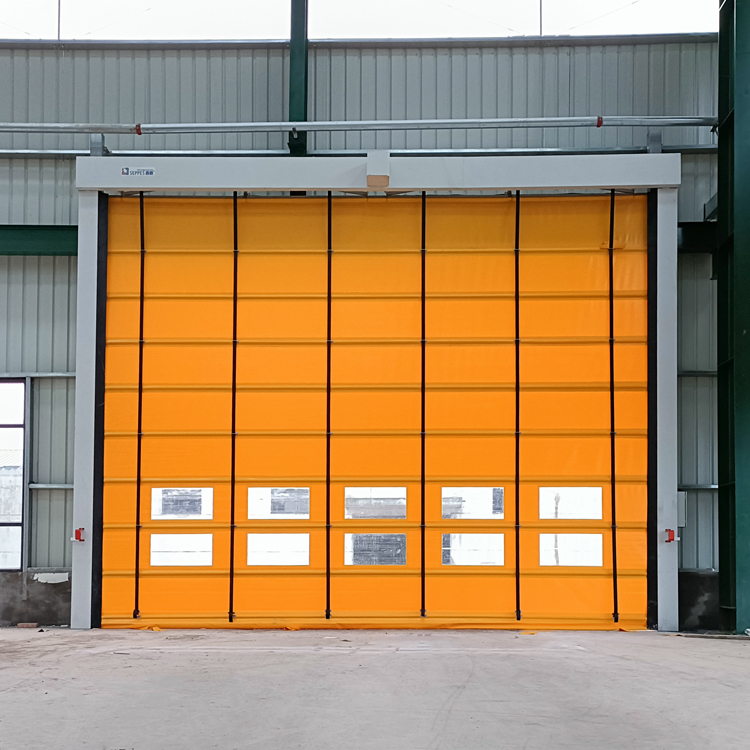
The High Speed Stacking Door opens upwards in a sectional folding and stacking fashion and is suitable for large openings and harsh environments.
Features:
Adopts flexible door curtain design with excellent wind resistance.
Suitable for oversized opening areas, such as airplane hangars, harbor storage, etc.
With a self-repairing function, it can be reset automatically after impact, reducing maintenance costs.
Applicable scenes:
Airports and hangars: protect aircraft and equipment from external environment.
Large logistics centers: suitable for high cargo throughput areas.
Terminals and harbors: adapt to all kinds of bad weather and improve operational efficiency.
Types and characteristics of traditional industrial doors
Sectional Overhead Door
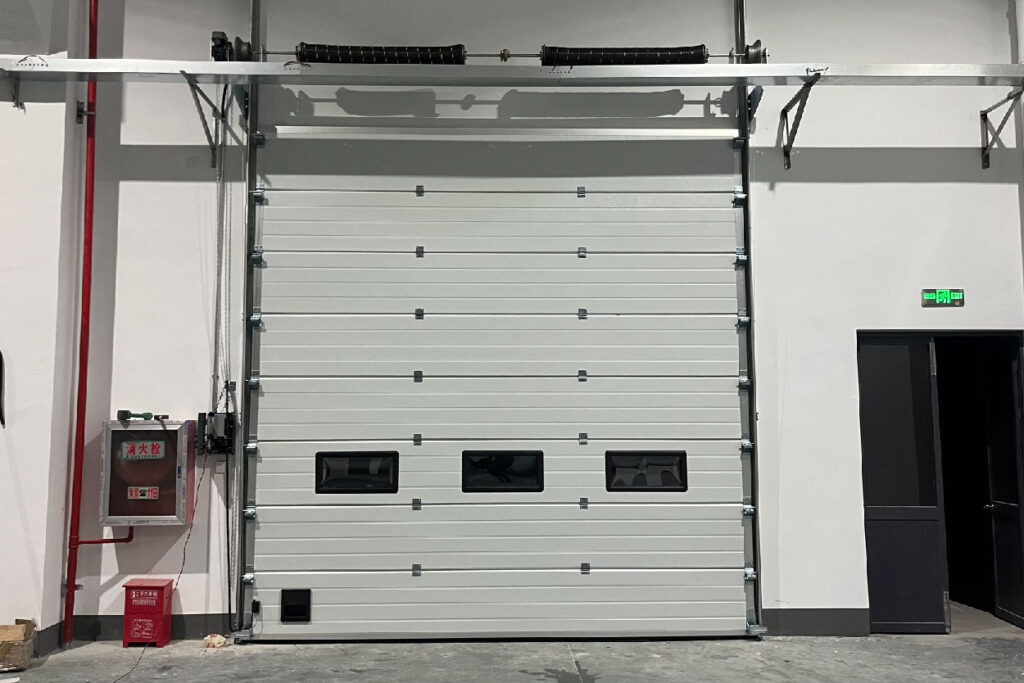
Sectional Overhead Door is a common type of traditional industrial door that consists of multiple panels connected in sections that slide along a track to the roof.
Features:
Metal or composite door panels with good thermal insulation.
Structurally stable and suitable for regular industrial premises.
Requires a certain amount of top space and installation is limited.
Applicable Scenarios:
Factories, garages, warehouses: suitable for places with low frequency of daily use.
Temperature-controlled warehouses: provide some thermal insulation, but the opening and closing speed is slow.
Rolling Shutter Door
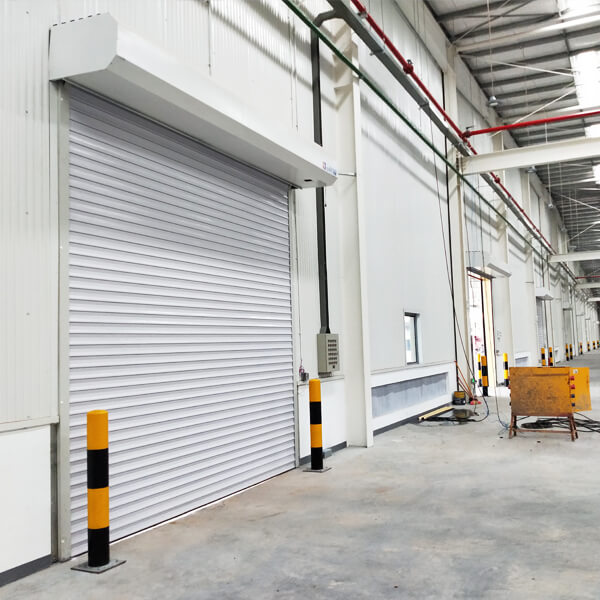
Rolling Shutter Doors consist of a series of metal curtains that are electrically or manually rolled up to the top of the door.
Features:
Simple structure, easy to install, suitable for small warehouses and stores.
Low cost, but poor sealing.
General safety performance, lack of intelligent protection measures.
Applicable scenes:
Garages, stores, low-budget industrial warehouses.
Temporary storage areas or places with low-frequency switching.
Swing Door
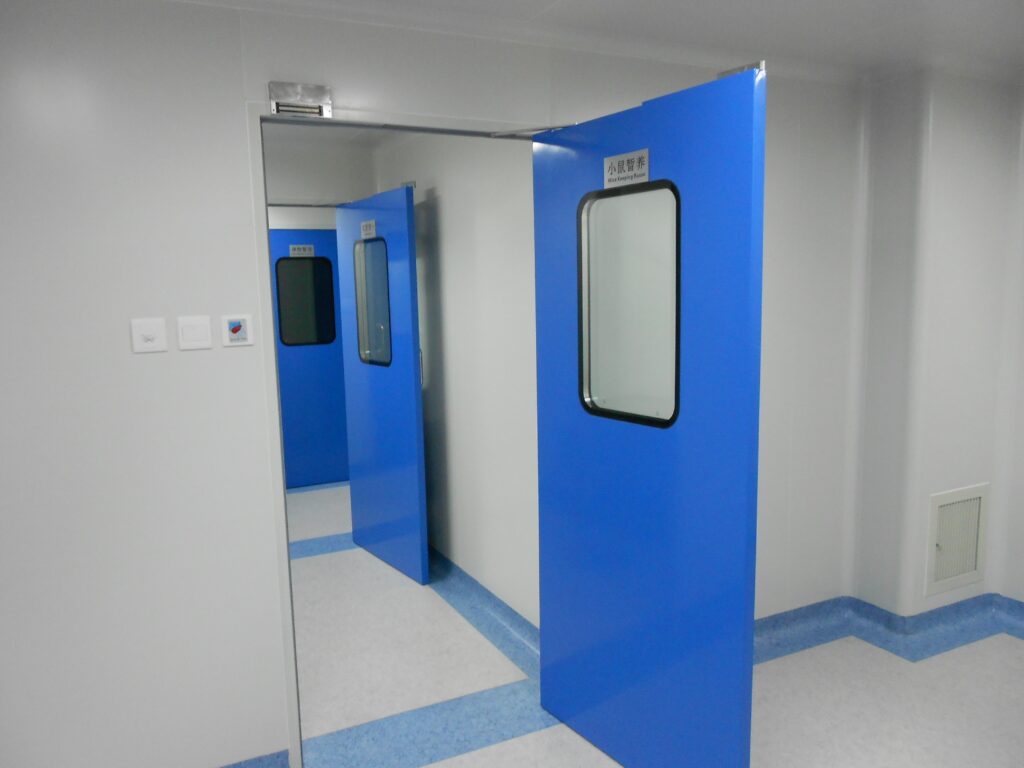
Industrial Swing Doors are constructed like home doors and can be operated manually or automatically.
Features:
Suitable for low-traffic areas and easy to use.
Inexpensive, but not suitable for high cleanliness environments.
Does not occupy top space, but requires additional opening space.
Applicable Scenarios:
Small laboratories, warehouse management offices.
Low-budget factories or logistic areas.
Sliding Door
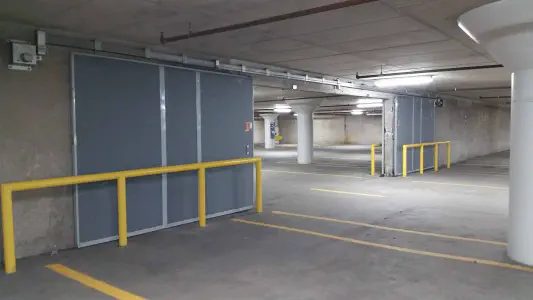
An industrial sliding door is a door that slides along a track and is suitable for larger opening areas.
Features:
Suitable for large area places, but the sealing performance is average.
Suitable for low-frequency opening and closing areas, not suitable for high-speed logistics operations.
Can be used in cold storage, but the sealing effect depends on the quality of installation.
Applicable scenes:
Cold storage, warehousing, and logistics center.
Large plants or places with low-frequency use.
Detailed Comparison of Fast Overhead Door VS Conventional Industrial Door
Comparison of opening and closing speeds
Fast Overhead Door opening and closing speed is between 0.8m/s and 2.0m/s, which can effectively reduce the waiting time and improve the working efficiency.
Conventional industrial doors have slower opening and closing speeds, usually between 0.1m/s and 0.5m/s, and are suitable for low-frequency use.
Comparison of energy consumption
Fast Door saves energy by reducing hot and cold air loss due to fast opening and closing.
Conventional industrial doors have long opening and closing times, resulting in high energy loss and increased operating costs.
Security Comparison
Rapid Overhead Door adopts an intelligent sensing system with an anti-collision function to improve safety.
The safety performance of traditional industrial doors is general, and some door types lack intelligent safety measures.
Maintenance Cost Comparison
Fast Overhead Door requires low maintenance and has a long service life.
Traditional industrial doors require regular maintenance and have higher long-term operating costs.
Comparison of applicable industries
Fast Overhead Door is suitable for logistics, food, medicine, and other high-frequency access places.
Traditional industrial doors are suitable for general factories, garages, stores, and other low-budget areas.
How to choose the right industrial door?
When choosing an industrial door, companies need to consider factors such as usage scenarios, industry needs, budget, security, and long-term operating costs. Below are the key selection guidelines:
Selection based on usage scenarios
High-frequency use scenarios (e.g., logistics centers, food processing plants): Fast Door is recommended because its high-speed opening and closing reduces waiting time and improves work efficiency.
Low-frequency use scenarios (e.g., small warehouses, garages, internal isolation areas in factories): traditional industrial doors may be a more cost-effective choice, as they are inexpensive and simple to maintain.
Choose according to security requirements
Areas with high safety requirements (e.g. production workshops, medical equipment storage areas): Fast Overhead Door offers an intelligent sensing system with an anti-collision function, which can effectively reduce the occurrence of accidents.
Areas with general safety requirements (e.g., general warehousing, stores): Traditional industrial doors can meet basic safety requirements and are suitable for companies with limited budgets.
Choose according to energy-saving needs
Places requiring good sealing and energy saving (e.g. cold chain logistics, drug storage areas): Fast Overhead Door can reduce the exchange of hot and cold air, reduce the load of air-conditioning and refrigeration equipment, and save energy costs.
Places that are not sensitive to energy consumption requirements (e.g., general factory buildings): Traditional industrial doors are still a viable option for low-frequency opening and closing, despite their mediocre sealing.
Selection according to budget
Enterprises with a limited short-term budget: Rolling Shutter Door or Sectional Overhead Door for lower upfront investment.
Businesses prioritizing long-term return on investment: Fast Overhead Door is recommended, as it has a higher initial investment but lower maintenance costs and is more economical to operate in the long term.
Maintenance Cost Comparison
Fast Overhead Door: lower maintenance requirements, durable door body, and long service life can reduce long-term operating costs.
Traditional Industrial Door: Some types (e.g. Roller Shutter Door) require frequent maintenance and replacement of parts, with higher long-term maintenance costs.
Future trends: Why Fast Overhead Door is the better choice?
With the development of automation and intelligence in the industry, the Fast Overhead Door is becoming the mainstream choice for industrial doors of the future.
Intelligent Integration
Remote Control and Intelligent Management: Many Fast Overhead Doors now support integration with factory automation systems to remotely control the opening and closing of the door, improving intelligent management.
AI monitoring: Some high-end doors are equipped with AI sensors, which can automatically adjust the opening and closing times according to parameters such as personnel, temperature, air quality, etc., further improving efficiency and energy saving.
Case: A multinational logistics company introduced an intelligent Fast Overhead Door in its warehouse center, which, combined with AI automatic vehicle identification, improved access control efficiency by 30%.
Environmental Protection and Energy Saving
Higher sealing performance reduces the energy loss caused by air circulation, reduces carbon emissions, and meets the requirements of sustainable development.
Increasing the use of recyclable materials for door bodies, such as aluminum frames and high-strength PVC, reduces the environmental impact of industrial waste.
Trend data: Market research shows that the popularity of Fast Overhead Door will continue to rise in the global industrial door market as its market share is expected to grow by 25% by 2030.
Broader Application Scenarios
In the past, Fast Overhead Door was mainly used in high-end manufacturing, such as automotive manufacturing, aerospace, and cold chain logistics.
In the future, with cost reduction and technological advancement, small and medium-sized enterprises will also begin to adopt Fast Overhead Door to enhance competitiveness and operational efficiency.
Market forecast: It is expected that the cost of Fast Overhead Door will drop by 10-20% in the next 5 years, making it the preferred choice of more and more enterprises.
Conclusion: How to choose the right industrial door for your business?
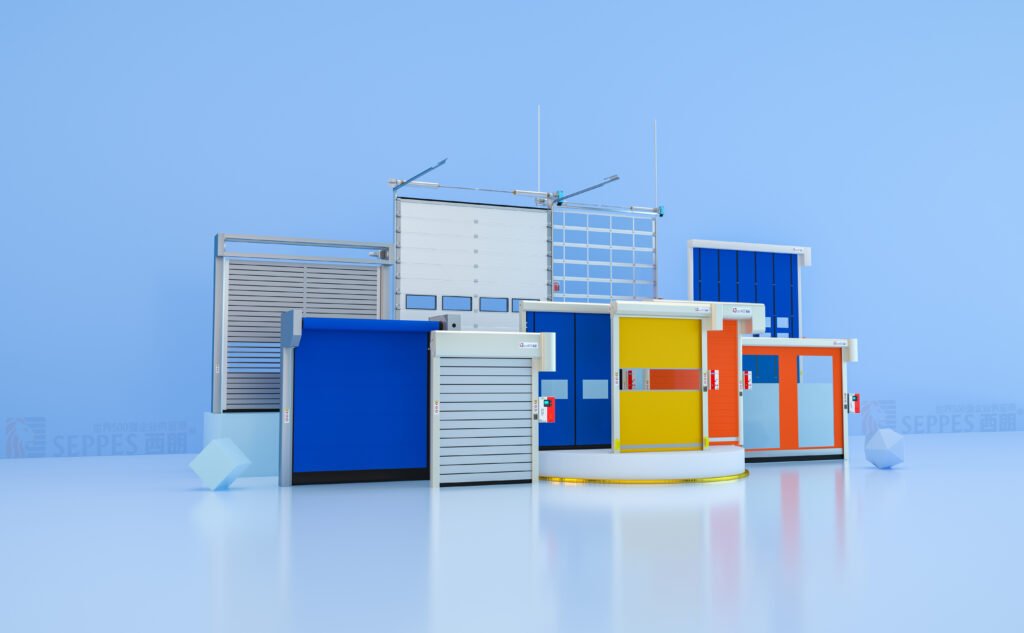
In a comprehensive comparison, Fast Overhead Door outperforms traditional industrial doors in terms of efficiency, safety, energy savings, and long-term returns, and is particularly suitable for the following scenarios:
Logistics centers, warehousing: high-frequency entry and exit places, reducing waiting time and improving efficiency.
Cold chain logistics, food processing: reduce temperature loss, reduce energy consumption, and meet hygiene requirements.
High-end manufacturing industry: enhance automation level and improve operational efficiency.
For sites with limited budgets and low-frequency use, the traditional industrial door is still an economical choice, but in the long run, Fast Overhead Door can help companies reduce operating costs, increase productivity, and improve overall competitiveness.
Ultimately, the choice of industrial door depends on a company’s operational needs, budget, and long-term investment strategy. As market trends evolve, Fast Overhead Door will become the ideal choice for more and more businesses.
FAQ: Fast Overhead Door vs Traditional Industrial Door
1. How much more expensive is a Fast Overhead Door than a traditional industrial door?
The initial cost of a Fast Overhead Door is typically 30%-50% higher than a traditional industrial door, but the long-term return on investment is better due to lower maintenance costs and energy efficiency.
2. What industries is the Fast Overhead Door suitable for?
Fast Overhead Door is suitable for logistics and warehousing, food processing, pharmaceutical factories, cold chain transportation, high-end manufacturing and other industries that require high-frequency switching, fast passage and good sealing.
3. Is the maintenance cost of Fast Overhead Door high?
No. Due to its highly durable materials, self-repairing curtains and intelligent control system, Fast Overhead Door requires far less maintenance than traditional industrial doors, making it more economical to use in the long term.
4. In what scenarios are traditional industrial doors better suited?
If a company has a limited budget and the door opens and closes infrequently (e.g., general garage, factory, low-traffic warehouse), a traditional industrial door is still an economically viable option.
5. How long does a Fast Overhead Door last?
A quality Fast Overhead Door can last up to 10-15 years, much longer than a traditional roll-up door (typically 5-8 years).
6. Is a Fast Overhead Door really energy efficient?
Yes. Its high-speed opening and closing reduces air loss and seals well, especially in cold chain logistics and clean room environments, which can significantly reduce energy consumption.
7. Does Fast Overhead Door support intelligent control?
Yes. Many models can be integrated with remote controls, sensing systems, and AI recognition to increase automation and optimize industrial operations.
If you have further questions or would like to know more about a specific application, please contact us for expert advice!

